广东省汕头市龙湖实验中学七年级英语上册 Unit 6 do y
广东省实验中学初中英语七年级上册Starter Unit 6(含答案解析)

考试范围:xxx;满分:***分;考试时间:100分钟;命题人:xxx 学校:__________ 姓名:__________ 班级:__________ 考号:__________一、选择题1.—Does your sister love red,Helen?—________.Her jacket and hat are red.A.Yes,I do B.No,I don'tC.Yes,she does D.No,she doesn't2.—Do you like oranges?—_________.I want to eat them now.A.Yes, I don’t B.No, I do C.Yes, I do D.No, I don’t 3.—_______does your father have________lunch?—Rice and tomatoes.A.What;for B.What;/ C.How;for D.How;/ 4.She wants________some ice-cream now.A.eat B.eats C.eating D.to eat5.Mary watch TV, but Mike .A.doesn’t;does B.doesn’t;doesn’t C.doesn’t;watches D.do;doesn’t 6.Volleyball stars must eat _________ and have _________ habits.A.good; good B.good; well C.well; good D.well; well 7.There are some ______ and ______ on the table.A.tomato; bread B.tomatoes; breads C.tomatoes; bread 8.People in the south of China like eating ______.A.rices B.noodles C.dumplings D.rice9.We should eat ______ food because it is good for our ______.A.unhealth; health B.healthy; healthy C.healthy; health D.health; healthy 10.Lisa has a ______ eating habit. She eats ______.A.good; good B.well; good C.well; well D.good; well 11.一What _______ does she like?一Rice.A.vegetable B.sports C.fruit D.food 12.—What do you have for breakfast?— _______ egg.A.A B.An C.The D./13.Ms. Hand is a ________ teacher at our school.And she plays tennis ________. A.good;good B.well;goodC.well;well D.good;well14.David asks Jim about his ________ habits.A.eat B.eating C.eats D.to eat 15.—Well, Let’s play computer games. —I’m sorry, ____ I’m busy now.A.and B.but C.so D.because 16.— Do you have any milk and chicken for dinner?— No, I ____. But David ____.A.don’t, has B.have, don’t C.don’t, does D.haven’t, has 17.一______your sister ______ salad?一Yes, she does.A.Does;like B.Does;likes C.Do;like D.Do;likes.18.______you like meat and fish?A.Does B.Would C.Will19.Mike often _______ hamburgers for breakfast.A.have B.has C.takes D.take 20.——Is there a museum near here?——Yes, ___ It’s on Center Street.A.it is B.there isn’t C.I don’t know D.there is 21.—Let’s go swimming after school. —I’d love to go, but ____.A.I don’t have swimming suits B.it’s boringC.it’s not difficult D.let’s go22.There is some ________ on the table.A.tomato B.egg C.chicken D.banana 23.—Laura, how about having some bread and fruit?—________.A.You're welcome B.That sounds good C.I don't know D.It's under the bed 24.—Let's get some ________.—OK. I want some ________.A.breads; hamburgers B.breads; hamburgerC.bread; hamburgers D.bread; hamburger25.—Does Jack like oranges?—No, he doesn't like ________.A.food B.fruit C.vegetables D.meat26.In the morning my sister always has ________ egg and some milk.A.a B.an C./ D.the【参考答案】一、选择题1.C 2.C3.A 4.D 5.A 6.C 7.C 8.D 9.C 10.D 11.D 12.B 13.D 14.B 15.B 16.C 17.A 18.B 19.B 20.D 21.A 22.C 23.B 24.C 25.B26.B【参考解析】一、选择题1.C解析:C【详解】句意:——海伦,你姐姐喜欢红色吗?——是的,她喜欢。
七年级上册unit6
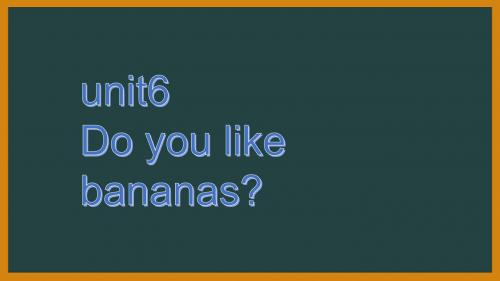
How about ____________chicken and rice for dinner? A.have B.to have C.having D.has
5、good和well
good adj. 其后接n. well adv. 修饰动词,一般放在句 末。
He is good student. He speak English very well.
7、like喜欢 like to do (一次性或者具体的动作或爱好)
like doing sth.(习惯性的动作或爱好)
8、可数名词/不可数名词 (1)glass (2)orange (3)chicken(4)fish
不可数名词 (1)salad (2)ice cream (3)food (4)fruit
9、许多
a lot of =lots of 许多+U/C
a lot 修饰动词(是一个adv.词组)
10、ask
~ sb. about sth.询问关于什么的 事情
He asks me about the meeting.
5.以o结尾的词,有生命+es,无生命+s 。如potato— potatoes tomato—tomatoes photo—photos 6.单复数同形 ,如sheep—sheep fish—fish deer— deer Chinese — Chinese Japanese—Japanese 特殊:man—men woman— women foot—feet tooth—teeth mouse—mice child—children
Do you like +n./pron./v-ing ?
Do you like oranges? Do you like them? Do you like reading books?
人教新目标英语七年级上册Unit-6全单元教案
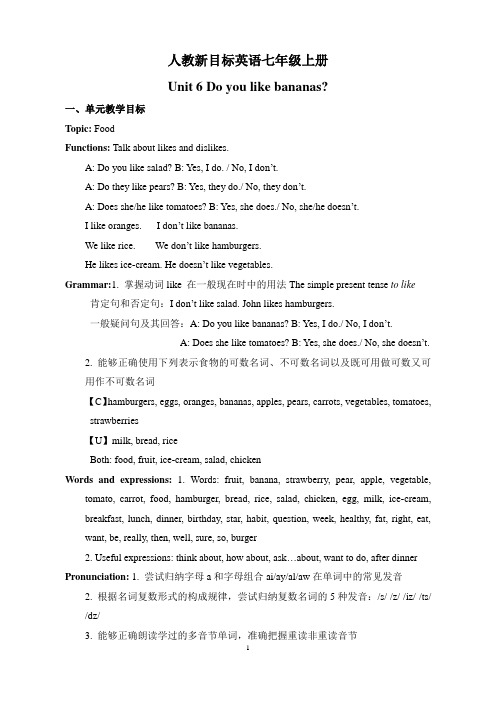
人教新目标英语七年级上册Unit 6 Do you like bananas?一、单元教学目标Topic: FoodFunctions: Talk about likes and dislikes.A: Do you like salad? B: Yes, I do. / No, I don’t.A: Do they like pears? B: Yes, they do./ No, they don’t.A: Does she/he like tomatoes? B: Yes, she does./ No, she/he doesn’t.I like oranges. I don’t like bananas.We like rice. We don’t like hamburgers.He likes ice-cream. He doesn’t like vegetables.Grammar:1. 掌握动词like 在一般现在时中的用法The simple present tense to like 肯定句和否定句:I don’t like salad. John likes hamburgers.一般疑问句及其回答:A: Do you like bananas? B: Yes, I do./ No, I don’t.A: Does she like tomatoes? B: Yes, she does./ No, she doesn’t.2. 能够正确使用下列表示食物的可数名词、不可数名词以及既可用做可数又可用作不可数名词【C】hamburgers, eggs, oranges, bananas, apples, pears, carrots, vegetables, tomatoes, strawberries【U】milk, bread, riceBoth: food, fruit, ice-cream, salad, chickenWords and expressions: 1. Words: fruit, banana, strawberry, pear, apple, vegetable, tomato, carrot, food, hamburger, bread, rice, salad, chicken, egg, milk, ice-cream, breakfast, lunch, dinner, birthday, star, habit, question, week, healthy, fat, right, eat, want, be, really, then, well, sure, so, burger2. Useful expressions: think about, how about, ask…about, want to do, after dinner Pronunciation: 1. 尝试归纳字母a和字母组合ai/ay/al/aw在单词中的常见发音2. 根据名词复数形式的构成规律,尝试归纳复数名词的5种发音:/s/ /z/ /iz/ /ts//dz/3. 能够正确朗读学过的多音节单词,准确把握重读非重读音节二、单元学情分析本单元的主题是使用动词like询问对方对食物的喜好;谈论自己与他人喜欢吃的食物,学习并掌握行为动词的一般现在时的使用。
七年级英语上unit6知识点

七年级英语上unit6知识点Unit 6: Talking about Future PlansAs a seventh-grade English learner, you've probably talked about what you and others are doing now and what you did yesterday. This unit focuses on talking about future plans. In this article, we'll explore the key grammar structures, essential vocabulary, and useful expressions to talk about your plans and dreams for the future.Verb Tenses for Future PlansTo talk about future plans, we need to use the future tense. There are several ways to form the future tense in English:1. "Will" + Verb: We use "will" to make predictions or talk about future events that we decide to do spontaneously.Example: I will travel to Paris next summer.2. "Going to" + Verb: We use "going to" to talk about future plans that we have already decided or arranged.Example: I am going to visit my grandparents next weekend.3. Present Continuous Tense: We use the present continuous tense to talk about future arrangements or plans that we have already made.Example: She is taking a flight on Friday to visit her friends in London.Vocabulary and Expressions for Future Plans1. Career: Some of the most common future plans revolve around career goals, such as getting a promotion, starting a business, or pursuing higher education. Here are some essential vocabulary words and expressions related to career goals:- I want to become a doctor/lawyer/engineer/teacher/artist.- I plan to go to college/university.- I hope to get a scholarship for my studies.- I'm thinking of starting my own business someday.- My dream is to work for a big company.2. Travel: Another popular topic for talking about future plans is travel. Here are some vocabulary words and expressions to describe your upcoming travels:- I'm planning to travel to Japan/France/Canada/Spain.- I'm going on a trip to Hawaii/Thailand/Italy next year.- My family and I are planning a road trip across the United States.- I've always wanted to go on a safari in Africa.- I'm hoping to backpack through Europe after I graduate from high school.3. Hobbies: You might also have future plans related to your hobbies or interests. Here are some words and expressions to describe your future plans in this area:- I'm going to take guitar/piano/dance lessons.- I'm thinking of joining a book club/a sports team.- My goal is to learn a new language.- I want to run a marathon someday.- I'm planning to start my own blog/vlog/Youtube channel.ConclusionTalking about future plans is an essential skill in English. It allows us to communicate our dreams and aspirations and share our goals with others. By learning the grammar structures, useful expressions, and essential vocabulary related to future plans, you'll be better equipped to speak confidently and fluently about your future plans in English.。
七年级英语上学期Unit6教案3~.docx

七年级英语上学期Unit6教案3〜 七年级英语上学期 Unit6 教案 3Unit6Doyoulikebananas? PeriodThree课前准备教师:搜集关于食物的图片,多媒体教学课件,制作表格 (见教学步骤)O学生:准备上一节课的家庭作业。
教学设计StepOne:Checkthehomework ・T:Nowlet‘ scxchangeyourexercisebooksandhelpeachother .Tryto corre ctit ・(Askdi fferentstud entstorepor this/hercon versation.)StepTwp:R eviewthewor ds.aminute. (Theteacherw illgivethes tudentsamin utetoprepar eit. Thenask someonetosa y.)S: Sala d, apples, ba nanas, icecr earn ・・・(Choo sethethrees tudentswhos aidthemosta ndgivesomef oodaspresen ts.)T:Youk d. NowLet' sp llsaythenam nowehavelelayagamewitesofthefood axntsomuchd hthefood. Le asmanyaspos eliciousfoo t' sseewhowi sibleduringStepThr ee:Newwords ・①Presentth enewords.T:Howmanym ealsdoyouha veeveryday?Ss:Three・T:Whatareth ey? (Thestud entscanansw ertheminChi nese.) Ss:Theyare〃早餐、中餐和晚餐〃.T:Oh, yes・ InEn glish〃早餐〃we cansay〃brea kfast〃・(S howapicture ofthebreakf ast)Reada fterme, 〃bre akfast〃・B-R-E-A-K-F-A-S-T, break fast・Ss: B -R-E_A-K_F_A-S_T, break fast.T:Do youhaveyour breakfastev eryday?SI :No, sometim eslgetuplat e, Ihavenoti metoeat.T : Ithinkit,s notgoodfory ourhealth・(Teachtheo thertwoword slunch, dinn erinthesame way.)(2)Pract icethewords ・T:Whichm ealdoyoulik ebest? (Poin ttoastudent ・)S: Hike breakfastbe st.T:Why?S:BecauseIl ikedrinking milk ・T: Wh oalsolikesb reakfastino urclass?Pleaseputupyou rhands ・T:Oh, somanyst udents ・ Youc ansitinthis team.(Ask allthestude ntswholikeb reakfast, lu nchordinner tocometothe sameteam .Th eycantalkea sily.)T:W ehavedivide dalltheclas sintothreegroups.0negr ouplikesbre akfast, theo thertwolike lunchanddin ner ・ Butwhat doyoulikefo ryourthreem eals?(Sho wapictureof threedinner s.)T:Ihav ethreemealp lates ・Whatd oyouwanttop utonit? Le stalkabou tit. Trytofindthefoodwhatyourgroup likemostand tellusthere ason.(Whe neachgroupi stalkingabo chergoesaro undamongthe studentsand theyneed ・ Th enaskeachgr ouptoreport ・)S:Inour group, welik ebreakfastbkeoranges, e ggs, milkand anapple ・ Beegoodforourh ealth, wecho osethem. (Whenthestud entissaying , theteacher putsthefoodontotheplat eforbreakfa st.)utit,thetea helpsthemif est. Weallli ausetheyare(Doit forlunchand dinnerinthe sameway.)T:Lookatla, andwritethe numberinthe boxnexttoth ecorrectfoo d.(Thenth estudentsfi nishoff la.)T: Howmany otherfoodwo rdscanyouad dtothechart ?Trytowri tethemdowni nthechart・F ruits:Veget ables:(Th estudentswr itethemdown assoonaspos sibleandthe nreadthem. S eewhowillad dmost・)St epFour:Prac ticethelist ening・T:L ook!Therear esomanyfood s. Maybethey areverydeli cious・ Which fooddoyouli ke?Doyoulik eapples? (Sh owthepictur e.)SI:…T:Howaboutchi cken?Doyoul ike it?SI:…T:Canyougu esswhatfood Hike?SI:Do youlike…?T:No, Idon't.S 2:Doyoulike •••?S3:Doyoul ike…?ndoutthefoo dyouhear.(Playtherec ording2ainS ectionB. The studentsfindouteachfoo dmentionedi ntheconvers ationonther ecording ・ Th encheckthea nswers ・)T :Nowopenyou rbooksandli stenagain. F illinthecha rt.heyarecorre ct.) T:Doe sSandralike salad?S:Yes , shedoes ・T: Workinpai rsaboutthec hart.StepFi ve:Task ・G oonapicnicw ithagroupof friendsandm akealistoff oodtobuy.©Dividethes tudentsinto sixgroups・(2)Talkabout whatthestud entsinyourg rouplikeandT:Yes, youarerig ht.Ithinkyo uareveryluc ky.Butlhave twofriends. TheyareSandraandTom. Do youknowhat foodtheylike?Now, let ,s listenandfi(Playt istentothee theircharts thenthestud herecordingonversation ・ Playtherec entscanchecthefirsttim andwriteint ordingthese ktheiranswee.Studentsl heanswersoncondtimeandrstobesuretdislikeandm akealist.③Theleaderi neachgroupr eportstothe class・Ste pSix:Summar yandhomewor k.Makeasu rveyabout/z W hat doyourpa ren tslikefo rthreemeals ?/z afterclas s.。
七年级上册英语Unit6 单元课件
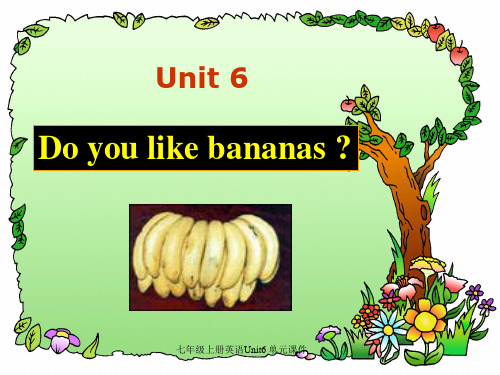
No , they don’t . 七年级上册英语Unit6 单元课件
Grammar Focus 2
Does __h_e__ like salad ?
Yes , he does . No , he doesn’t .
Does __sh__e_ like salad ?
七年级上册英语Unit6 单元课件
可数名词复数形式的构成 1
名词特点 词尾加法 词尾读音方法
例词
一般情况下
加-s
1. -s在清辅音后读[s]
desks
2. -s在浊辅音后读[z]
apples
3. -s在元音后读[z]
trees
4. 以音素[ s , z , , 读[iz]
]结尾的,
oranges
以-s, -x, -sh, -ch 结尾的
hamburgers tomatoes French fries oranges bananas strawberries
eggs
apples vegetables carrots pears
broccoli water milk bread tea
ice cream salad chicken
meat
动词一般现在时的疑问句式
(1)be 动词
Am Is 主语+ 表语
Are
(2)have 动词
Do Does (三单)
主语+ have+宾语+?
(3)行为动词
Do Does
(三单七)年级上主册英语语Uni+t6 单元动课件原+状语+?
1.He likes salad. ( 划线部分提问 ) _w_h_a_t_ _d_o_e_s_ he like ? 2.They like tomatoes. (一般疑问句) _D__o_ they like _t_o_m_a_t_o_e_s _ ? 3.We like carrots very much. _W_h_o _lik_es_carrots very much ?
广东省汕头市龙湖实验中学2022-2023学年七年级上学期期中英语试题(含解析)

广东省汕头市龙湖实验中学2022-2023学年七年级上学期期中英语试题学校:___________姓名:___________班级:___________考号:___________二、语法选择三、完形填空16.A.isn’t B.aren’t C.doesn’t D.don’t 17.A.at B.with C.of D.for 18.A.good B.nice C.well D.fine 19.A.him B.her C.it D.them 20.A.relax B.study C.play D.read 21.A.because B.or C.then D.but 22.A.big B.small C.quiet D.noisy 23.A.learn B.speak C.sleep D.rest 24.A.interesting B.boring C.beautiful D.important 25.A.time B.desk C.room D.light四、阅读单选五、阅读匹配配对阅读。
左栏是五个人遇到的学习问题,右栏是相应的建议。
请将左栏的问题与右栏六、用所给单词的正确形式填空七、根据首字母填空九、根据句意及音标填空十一、短文语境提示填空十二、读写综合A.回答问题以下是一篇关于地球日的科普文章,阅读该文章,并回答以下5个问题。
参考答案:1.B 2.A 3.D 4.G 5.F【分析】B的狗狗Dannis丢了,Gina提供了一些帮助。
1.根据回答“ It’s black and white”可知,问句询问的是颜色,B选项“你的狗是什么颜色”符合情景。
故选B。
2.根据回答“D-A-N-N-I-S.”可知,问句询问如何拼写,A选项“你怎么拼写”符合情景。
故选A。
3.根据“He is in the classroom now. ”可知,问句询问位置,用where引导的特殊疑问句,D 选项“李老师在哪里”符合情景。
广东省汕头市龙湖实验中学七年级英语上册 Unit 6 do you like bananas Section A课件 (新版)人教新目标版
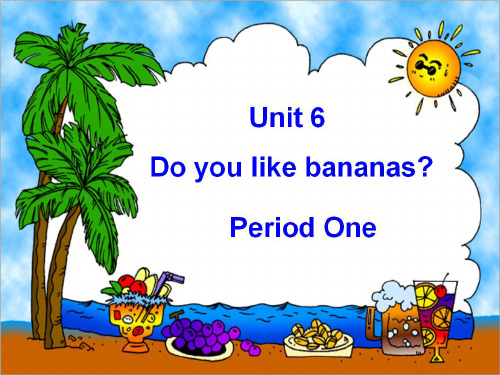
potatoes
Vegetables:
carrots
Brainstorming broccoli
a piece of tomato three tomatoes
salad
a carrot
some carrots
apoptaottoaetso
French fries
potato chips [pə'teItəʊ] [tʃIps]
Unit 6 Do you like bananas?
Learning goals
1. To talk about what you like or dislike 2. To learn some words about food 3. To tell countable nouns from
uncountable nouns
the things in the picture.
1. hamburgers ____ d
2. tomatoes 3. oranges
____ i
____
4. ice-cream ____ f
5. salad
____ h
6. bananas ____ 7. strawberries ____
b
8. pears
apple, banana, orange, pear, strawberry, tomato, hamburger, carrot, vegetable, French fries
ice-cream, salad, fruit, chicken, food milk, bread, rice
1a Match the words with
potato chips
英语七年级上册Unit6Doyou

While-writing
Breakfast
I like
I don’t like
Fill in the blanks and writing.源自LunchDinner
While-writing
My Eating Habits
Hello! My name is Ruby. I have good eating habits. For breakfast I like milk, eggs and bread, but I don’t like hamburgers. For lunch, I eat rice and chicken and carrots, but I don’t like tomatoes . I have salad for dinner. I don’t like icecream . I don’t want to be fat. So I think I am very healthy.
Go on
My eating habits. Breakfast
I like
I don’t like
Lunch
Dinner
While-writing
My Eating Habits
Hello! My name is Ruby. I have good eating habits. For breakfast I like milk, eggs and bread, but I don’t like hamburgers. For lunch, I eat rice and chicken and carrots, but I don’t like tomatoes . I have salad for dinner. I don’t like icecream . I don’t want to be fat. So I think I am very healthy.
七年级英语上册第六单元Unit

Listen and circle
hamburgers
pears
broccoli
French fries
oranges
ice cream
salad
bananas
2a
2b Listen again and fill in the blanks
broccoli
broccoli
ice cream
ice cream
broccoli
broccoli
ice cream
an ice cream
Do you like__________? __________. strawberries Yes, I do Does she like strawberries? Yes, she does
Do you like salad?
Name
eggs
tomatoes
bananas
salad
apples
carrots
Mary
Bob
Unit 6 Do you like bananas? Period 3
a strawberry
fruits an orange a pear a banana Do you like oranges?
a strawberry(草莓)
PART 4
four pears
a pear
PART 5
carrots
a carrot
PART 6
ice cream 冰淇淋
salad (沙拉)
broccoli broccoli 花椰菜
hamburgers tomatoes broccoli French fries orange ice cream salad bananas strawberries pears
广东省汕头市龙湖实验中学七年级英语上册《Unit 6 Do you like bananas》教案
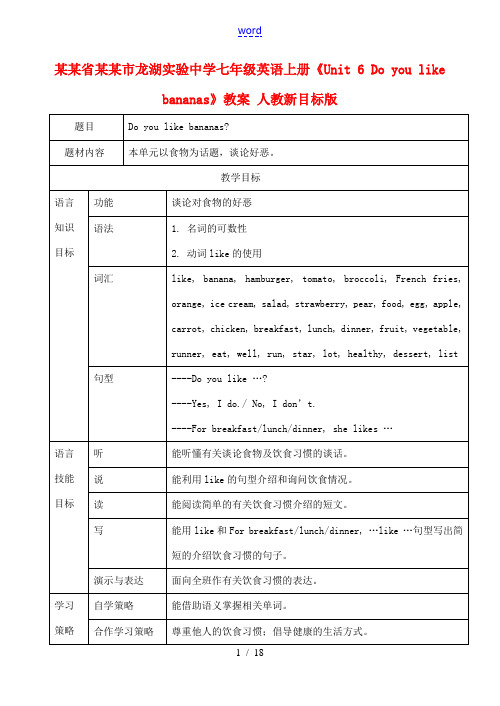
某某省某某市龙湖实验中学七年级英语上册《Unit 6 Do you likebananas》教案人教新目标版Teaching design:Period 1: Section A (1a—1c)Period 2: Section A (3a,3b)+Section B(1a—1c)Period 3: Section B(2a—3c)Period4: Self-checkPeriod 1: Section A (1a—1c)Teaching aims:1.学会日常生活中食物水果的名称Language points:1.要求掌握以下句式(1)Do you like┅ Yes I do/No I don’t(2)I like┅ I don’t like2.要求掌握以下词汇knowledge tomatoes broccoli French fries oranges ice cream salad bananas strawberries carrotsDifficulties(1) 可数名词和不可数名词(2) 可数名词的复数形式Teaching steps1.warning-up and revision1) Daily greeting to the students2) Revision(复习) I have┅ Do you have ┅?T: Good morning /afternoon/children (showing a ) fruit basketI have a fruit basket Do you have a fruit basketAsk the students to ask and answer using the pattern::Do you have┅?2. Guessing gamesTaking away the fruit basket and asking the students to guess: What’s in the basket? Using the sentence: Do you have┅? Present the names of all kinds of fruits and food3. Showing a picture of fridge in the puterRevise the names of food and fruitTeach the new words of food and fruit4. Practise1a. match the words with the pictures2a. Listen and circle the food you hear5. Show the picture again or take out an apple, act out eating an appledelicious and say:I like apples for several times then take an egg, “I don’t like eggs”for several times, working a horrible face at them (Ask more questions about fruits and food )6.Guessing gameGuess what my favourite food is, or ask some students to e to the front and guess what her/his favourite food is.7. Fill in the chartAsk the students to talk about their likes and dislikes in talking pairs9. Listening1b. Listen and number the conversation10. HomeworkOral work:Recite the new wordsWritten work:1. Copy the new words in Section A;2. Making up dialogues between you and your parents about likes and dislikes 板书设计:Countable nouns Uncountable nouns Countable and uncountable nouns hamburgers, broccoli, ice cream,strawberries, rice, salad,French fries, coffee, chicken,………教学反思:Period 2: Section A (2a—4)Teaching aims:1 学会谈论第三人称(he/she)的喜好2 巩固有关食物的单词Language points:1. 要求掌握以下句子(1)—Does she/he like apples?—Yes,she/he does,she/he likes apples.—No,she/he doesn`t,she/he doesn`t like apples. (2)—Do they like apples?—Yes,they do,they like apples.—No ,they don`t .Thet don`t like apples.2. Difficulties(1)Does……do sth?的动词要用原形(2)He/She likes apples.中的动词后一定要加“s”Teaching steps:1 Warming-up and revision1) Play a guessing gameT:show pictures of food,drinks,fruits fast.Ss:guess one by one and spell it.T:check it and show the correct spelling on the right.Listen(to 2b)and fill in the form (Ask S2 to read the dialogue to check the answer) 2 Presentation(From the listening material we know the boy`s and the girl`s likes and dislikes.Now I want to know what you like and dislike)(1)T:(To a boy student)Do you like tomatoes?S1:Yes,I do.T:(To Ss)Does he like tomatoes?Ss:Yes,he does. He likes tomatoes.(Ss look at the screen and read them again)T:(To St2)Do you like salad?St2:No,I don`t.T:(To Ss)Does he like salad?St2:(helped by the teacher)No,he doesn`t. He doesn`t like salad.(Ss look at the screen and read them again)(2)T:(To a girl student)Do you like ice cream?S1:Yes,I do.T:(To the Ss)Does she like ice cream?Ss:Yes,she does. She likes ice cream.(Ss look at the screenand read them again)T:(To S2)Do you like tea?S2:No,I don`t.T:(To Ss)Does she like tea?Ss:No,she doesn`t.She does like tea..3. Practice(1)Ss do the same as the teacher.(2)Ss practise them in groups.Ask Ss to act it out.(3)Ask Ss to write out his partner`s 2 likes and 2 dislikes.(4)Let Ss have a petition between the girls and boys using the key phrases.(T gives an example)Does she/he like……?S1:(look at the student`s sentence)Yes,he does.He likes……No,he doesn`t.He doesn`t like……)(5)Summarize the petition4. Presentationand practice(1) T show pictures of 姚明andX翔and ask:Who are they?Ss:They are ……T :Do they like carrots?(Ss may know but most don`t .T ask Ss to look at the chart andgive their answers)Yes,they do.they like ……No,they don`t .They don`t like……(2)T show pictures of郭晶晶and蔡依林and ask :Who are they?(4)Ask several pairs to talk about their likes and5 Work on Part3(P33)(1)SA look at Page33 and ask questions and fill in the blanks.(2)SB look at Page83 and ask questions and fill in the blanks.(3)Ask 2 pairs to read out their answers.6. Make a food surveyT:I`m going to have a birthday party,so I want to buy some food, fruits and drinks.Please help me find out what they like and don`t like and finish the chart.Ss finish the chartT ask S4 to report their survey to the teacher.He/She like…They don`t like…He/She doesn`t like……7. Homework(1)Make an interview to you friend about his father and mother`s likes and dislikes and record it.(with the key phrases)(2)Finish 《全品》Section A板书设计:—Does she/he like apples?—Yes,she/he does,she/he likes apples.—No,she/he doesn`t,she/he doesn`t like apples.—Do they like apples?—Yes,they do,they like apples.—No ,they don`t .Thet don`t like apples.教学反思:Period 3: Section B (1a—2C, 4a-4b)Teaching aims:1.巩固所学的食物及水果名词。
七年级上册英语第六单元教案
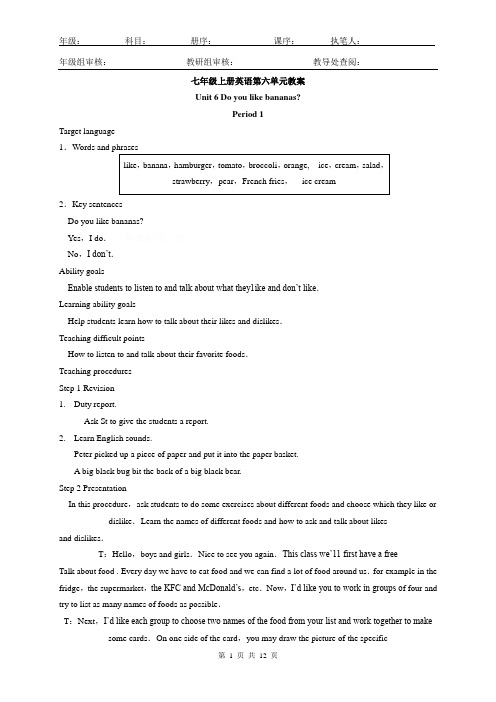
年级:科目:册序:课序:执笔人:年级组审核:教研组审核:教导处查阅:七年级上册英语第六单元教案Unit 6 Do you like bananas?Period 1Target language1.2.Key sentencesDo you like bananas?Yes,I do.No,I don’t.Ability goalsEnable students to listen to and talk about what they1ike and don’t like.Learning ability goalsHelp students learn how to talk about their likes and dislikes.Teaching difficult pointsHow to listen to and talk about their favorite foods.Teaching proceduresStep 1 Revision1.Duty report.Ask St to give the students a report.2.Learn English sounds.Peter picked up a piece of paper and put it into the paper basket.A big black bug bit the back of a big black bear.Step 2 PresentationIn this procedure,ask students to do some exercises about different foods and choose which they like or dislike.Learn the names of different foods and how to ask and talk about likesand dislikes.T:Hello,boys and girls.Nice to see you again.This class we’11 first have a freeTalk about food . Every day we have to eat food and we can find a lot of food around us.for example in the fridge,the supermarket,the KFC and McDonald’s,etc.Now,I’d like you to work in groups o f four and try to list as many names of foods as possible.T:Next,I’d like each group to choose two names of the food from your list and work together to make some cards.On one side of the card,you may draw the picture of the specificfood with its Chinese name and on the other side of the card,you should try to write the English name for it,understand? You can use the dictionaries when necessary.Three minutes 1ater.show some of their cards about different foods and ask for the English names.T:Can you tell me the names for the foods in the picture?Help students learn the names of different foods and encourage them to say as many names as possible. Step 3 DrillT:Do you like apples?S:Yes, I do.T:Do you like bread?S:No,I don’t.T:Excellent.As we know.there are many kinds of food in the world and people in different countries T:In the picture,we can see many people.They are have different main food and their favorites.But nowadays people in different areas can enjoy various foods from all overthe world.And we know different people have different tastes.Today we will learn to talk about people’s likes and dislikes about food.Step 4 PracticeIn this procedure,students will learn the names of some foods and learn to talk about the foods they know.After three minutes.Ask students to say their names talking about their likes and dislikes about foods.Now please work in pairs and read the conversations.Then listen to the three short conversations and finish activity lb.T:Do you like apples?S:Yes, I do.T:Do you like bread?S:No,I don’t.Ask students to practice the conversations above in pairs and then make their own conversations using the target language.T:We know in the listening material,A and B are talking about some food like bananas,salad and oranges.Now,can you think of the names of some other food and practice talkingabout them in pairs? Move around the classroom to help students and then ask a pair of students to say the conversation before the class.Step5 ConsolidationLet’s summarize what we learnt in this unit课后小记年级:科目:册序:课序:执笔人:年级组审核:教研组审核:教导处查阅:Period 2Target language1.Words and phrases2Ability goalsEnable students to talk about likes and dislikes.Teaching difficult pointsHow to talk about likes and dislikes.Teaching aidsA tape recorder.Some objects.Teaching proceduresStep 1 RevisionT:We can see hamburgers in the picture with the letter d.So what about tomatoes?T:Good.Please write ‘‘g’’ on the line next to the word “tomatoes”.Clear?Ask students to finish the activity and then read the conversations in the picture and then ask students to read and listen to the conversations.and then number them in order.Point out the boxes where students have,oh,countable noun,uncountable. Play the tape for the secondtime.Ask the students to listen to the recording again and try to finish the sentences in the picture.T:We can see some pictures and some sentences in2b.In the first picture we can see some hamburgers.Do you know the food in picture 2? Check the students’ homework and ask them to spell some new words and make a dialogue about their food. Get the students to talk about the last two pictures likes and dislikes.What’s your favorite food?Step2 PresentationT:Good.Do you like French fries?S:No, I don’t.But I like ice cream very much.and choose the names for the food from 2a.Then ask them to listen to the tape again and try to finish the sentences in the pictures.Play the recording again,check the answers.And then ask students to listen again and repeatafter the recording .Write ‘‘hamburger’’,‘‘French fries’’ and ‘‘ice cream’’Step 3 DrillAsk the students to read the words in the box and talk about the pictures first,then listen tothe recording and finish activity 2b.Invite one student to practice reading and telling the meanings of the words.And then ask all the students to read after the teacher and finally ask them to Then ask some pairs of students to act out their practice reading by themselves.T:Next we’11 listen to three c onversations.In the conversation,a boy and a girl aretheir likes and dislike about food.Step 4 PracticeAsk students to work in pairs to practice the aboveT:Thank you.Next,I’d like some pairs to practice conversations and give answers that aretrue to your conversations in the front of the class,any themselves.I’11 give the best pair a prize as a gift. Sl:Do you like strawberries?S2:Yes, I do.SI:Do you like bananas?S2:No, I don’t.But I like tomatoes.Now I’d like you to write down the names of food you like and don’t like.Step 5 ConsolidationAsk students to review the grammar box and make sure they have mastered ‘‘do/does’’ questions and countable nouns and uncountable nouns. First ask students to talk about the use of the third person singular.T:As we can see from these sentences,the t11ird person singular forms all contain an “s”,while the other forms do not.What is the third person singular main verb? What is the third person singular helpingverb?Ask students to read the following phrases.Show the following.a pear;an apple/egg/orange;two tomatoes;three applesmany oranges;many eggs;much broccoli;much salad;some broccoli;some apples;a lot of ice cream;a lot of French fries课后小记年级:科目:册序:课序:执笔人:年级组审核:教研组审核:教导处查阅:Period 3Target language1.Words and phrasesfood,strawberry2.Key sentencesWhat does Bob/Bill 1ike?Wh at doesn’t Bob/Bill like?Do you like…‘? I likeAbility goalsEnable students to talk about the food that others like and dislike.Learning ability goalsHelp students 1earn how to talk about the food that others like and dislike.Teaching difficult pointsHow to talk about the food others 1ike and dislike.Teaching aidsPictures of some food.Teaching procedureStep 1 RevisionFirst give the English pronunciations of the names for some food and ask the students to spell them on the blackboard and tell the Chinese meanings of them.Then ask some students to practice some conversations using different persons with the help of the words on the blackboard.Reference words:broccoli,French fries,bananas,pears,ice creamStep 2 PresentationA sample version:Liu Li likes tomatoes.He doesn’t like hamburgers.Zhao Jun doesn’t like tomatoes.He likes bananas.Zhao Li likes French fries and pears.But she doesn’t 1ike salad.Step 3 DrillAsk students to talk about the pictures,learn the names of the characters,explain the two kinds of faces and write the names of foods on the blackboard so as to help them make new conversations.T:Look at the pictures on the right.What are the names of the two men?S:Bob and Bill.T:Good! Do you know the simple drawings of the two kinds of smiles? Can you tell what they mean? S:Yes.They are happy smiles and sad smiles.A happy smile means like.A sad smile means dislike.Step 4 PracticeWhat does Bob/Bill 1ike?Wh at doesn’t Bob/Bill like?Do you like…‘? I likeStep 5 ConsolidationAsk students to work in groups of four.First let them talk about the different foods in the picture and write down the names for each of them.After that they can ask and answer questions about their likes and dislikes and write down the names of the classmates.Then ask them to pass the charts .Encourage studentsT:Quite fight.Now,please talk about the food in the pictures and write down their English names in your notebooks.Step 6 Homework课后小记年级:科目:册序:课序:执笔人:年级组审核:教研组审核:教导处查阅:Period 4Target language12.Key sentences1. Does Tom like carrots?2. Yes,he does.3. I 1ike carrots!Ability goalsEnable students to talk about likes and dislikes and the difference between fruits and vegetables.Learning ability goalsHelp students learn how to talk about likes and dislikes.Teaching difficult pointsHow to talk about what others like and don’t like.Teaching proceduresStep 1 RevisionCheck the homework.Talk with students freely and ask them to give some English names for food.And then ask some of them to tell what food others likeStep 2 PresentationT:Glad to meet you again,boys and girls.Now you know many names of fruit and food,don’t you? S:Yes, we do.T:Can you tell me some?S:OK.Apples, pears, strawberries.T:Very good.What else?S:Salad, hamburgers.T:Great! Now,I’d like some of you to tell us what food your classmates like and dislike.Now who’d lik e to show.Cai Jun likes apples.He doesn’t like hamburgers.Chao Jun doesn’t like tomatoes.Helikes bananas.Du Lin likes French fries and salad but she doesn’t like fruits.Wu Han and Sun Bing both like strawberries but they don’t like chicken…T:Well done! As we know.We have various foods for three meals,ie,breakfast,lunch and dinner.Now,who can tell me the meanings of these words?S:In the morning, we have breakfast. At noon we have lunch.And in the evening we have dinner.T:Excellent! I see you have known a lot about the eating habits of your classmates.But whatabout yourself? Can you tell me what you usually have for three meals? You may talk with your partner and prepare for it first.Try to speak in English.S:I usually have eggs, noodles, milk for breakfast, rice,chicken,fish,carrots, potatoes for lunch , rice chicken , potatoes .T:Good! Next we will learn more about the food for three meals every day and talk about people’s likes and dislikes.Step 3 DrillAsk students to work in pairs,look at the chart(1b),T:Now,please look at the 1ists in the chart.We can see that apples are fruits while brocco1i is a kind of vegetable,so can you tell me some vegetables?( potatoes.carrots.onions.)T:Good! Look at the pictures in la again and tell me what me vegetables are.Now,can you add some words to the lists on the right?I’11 give you three minutes towork with your partner and list as many fruits and vegetables as you can.Sample list:fruits:pears,strawberries,watermelon,grapes,and bananas...vegetables:cabbage,cucumber,eggplants,carrots,broccoli and potatoes...Step 4 PracticeAsk students to talk about the likes and dislikes for three meals of Tom and Sandra and then tell which picture shows the food either of them has for the meal.T:Since we have listened to the recording for many times and you have known a lot about the eating habits of Tom and Sandra.Now please work in pairs,ask and answer questions about what Sandra and Tom like and don’t like.You may look at the chart above where necessary.Sample dialogue:Sl:Does Sandra like apples?S2:Yes, she does.Sl:Does she like vegetables?S2:No, she doesn’t.Ask students to look at the breakfast, 1unch,and dinner in activity l a and decide whom each of them belongs to.Check the answers with students.Step5 ConsolidationLet’s summarize what we learnt in this unit课后小记年级:科目:册序:课序:执笔人:年级组审核:教研组审核:教导处查阅:Period 5Target language1.Words and phrasesbe,eat,well,rice,star,lot,lots of, healthy,2.Key sentencesI like apples.Do you like appleYes,I do.Do you like oranges?Ability goalsEnable students to write about the favorite foods for three meals and make a list of food for shopping.Learning ability goalsHelp students make a list of food they would like to have and buy.Teaching difficult pointsHow to make a list of food they like.Teaching proceduresStep 1 Revision ’Ask students to write some words 1earnt in la,and then say something about the food Sandra and Tom like and don’t like.T:Boys and girls,we have learnt many words in la.Now let’s have a dictation. ice cream,banana,carrots,broccoli,saladNext ask students to tell fruits from vegetables from the following.Show the following.apples,carrots, salad,bananas,oranges,broccoliSample answers:Fruits:bananas,apples and oranges.Vegetables:broccoli,salad and carrot.T:Very good.So now you can tell fruits from vegetables. In this period we will learn moreabout fruits and vegetables and then write about the favorite food for three meals and shopping lists.Step2 PresentationAsk students to look at the pictures in 3b carefully and then write about what Tom likes to eat for breakfast,lunch,and dinner.T:Now,please look at the pictures carefully.Can you name the food Tom eats for lunch anddinner? Finish the passage please.S:For lunch,he eats hamburgers。
广东省实验中学初中英语七年级上册Unit 6(含答案解析)

一、选择题1.— Does your sister eat very ____ at school? — Yes, she ____.A.good, do B.well, does C.well, is D.good, does B解析:B【详解】句意:——你的妹妹在学校吃的好吗?——是的,她吃得很好。
考查形容词副词辨析及助动词。
good好的,形容词;well好,副词;do助动词,用于一般现在时;does用于主语为第三人称单数时。
根据句子结构可知,第一个空修饰动词eat,应用副词,排除A和D;第二个空前主语she是第三人称单数,因此应用does。
故选B。
2.-Sir, you shouldn’t smoke in this area.-Oh, I am very sorry.A.street B.forest C.place C解析:C【解析】【详解】句意:--先生,你不应该在这个地方抽烟。
--哦,非常抱歉。
A. street街道;B. forest森林;C. place地方。
area“地区,地方”的意思。
故本题选C。
3.—What do you have for breakfast?— _______ egg.A.A B.An C.The D./B解析:B【详解】句意:——你早餐吃什么?——一个鸡蛋。
表示“一”这个概念,排除CD,此处egg是元音音素开头,故用不定冠词an修饰,故选B。
4.—Tom likes eggs _______ breakfast.—I don’t like eggs at all.A.with B.in C.for D.by C解析:C【详解】句意:——汤姆喜欢早餐吃鸡蛋。
——我一点也不喜欢鸡蛋。
with和……一起,in在……里,for为了,by凭借。
for breakfast作为早饭,是固定搭配。
故选C。
5.I like _______ , but my sister likes _______ .A.milk; chickens B.milks; chicken C.milk; chicken D.milks; chickens C解析:C【解析】【详解】句意:我喜欢牛奶,但是我的姐姐喜欢鸡肉。
- 1、下载文档前请自行甄别文档内容的完整性,平台不提供额外的编辑、内容补充、找答案等附加服务。
- 2、"仅部分预览"的文档,不可在线预览部分如存在完整性等问题,可反馈申请退款(可完整预览的文档不适用该条件!)。
- 3、如文档侵犯您的权益,请联系客服反馈,我们会尽快为您处理(人工客服工作时间:9:00-18:30)。
I
like
fruit and vegetables
水果和蔬菜 healthy food
apples
tomatoes
bananas
pears
strawberries salad
可/不可数
oranges
broccoli
不可数
I don’t like junk food垃圾食品
French fries
This is a fridge (冰箱). What’s in the fridge?(猜猜冰箱里有什么?)
some vegetables ['vedʒtəblz]
some fruits
Brainstorming
pears
fruit:
strawberries
bananas
oranges
half an apple
potato chips
hamburgers
ice cream可/不可数 cola不可数
自学内容:Review the words and fill in the chart. (将所学单词归类)
countable noun (可数名词)
countable noun& uncountable noun uncountable noun (不可数名词)
____ g
9. milk 10. bread
____ c ____ j
e
a
一天一苹果,医生远离我
当堂训练
请认真完成《基础小练 习》P47 –P48并校对
Unit 6 Do you like bananas?
Learning goals
1. To talk about what you like or dislike 2. To learn some words about food 3. To tell countable nouns from
uncountable nouns
an apple
three apples
z/
an orange ['ɔrIndʒ]
N. 橙子; 橘 N.& ADJ. 橙色 (的)
two oranges ['ɔrIndʒIZ]
six pears
SOME
BANANAS
A STRAWBERR Y
many strawberle, banana, orange, pear, strawberry, tomato, hamburger, carrot, vegetable, French fries
ice-cream, salad, fruit, chicken, food milk, bread, rice
1a Match the words with
chicken ['tʃIkIn]
many chickens
TWO HAMBURGERS
ice-cream ['aIs'kri:m]
milk a glass of milk
[mIlk]two glasses of milk
a bag of rice
bread
a piece of bread two pieces of bread
the things in the picture.
1. hamburgers ____ d
2. tomatoes 3. oranges
____ i
____
4. ice-cream ____ f
5. salad
____ h
6. bananas ____ 7. strawberries ____
b
8. pears
potatoes
Vegetables:
carrots
Brainstorming
broccoli
a piece of tomato three tomatoes
salad
a carrot
some carrots
apoptaottoaetso
French fries
potato chips [pə'teItəʊ] [tʃIps]
